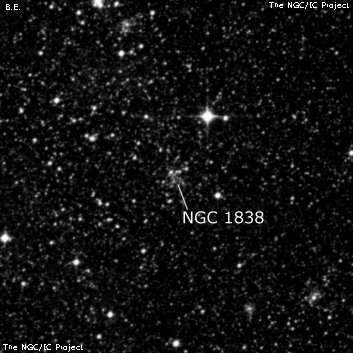
There are three Shapley-Lindsay clusters (not specifically mentioned by Herschel) at the edges. S-L 225, at the southwest edge, appeared fairly bright, round, 50" diameter. Several mag 14-16 stars are resolved, particularly along the north side. Located 2' SSE of mag 8.2 HD 33617. A mag 11.7 star is 1.3' WSW. S-L 230, at the northern edge, appeared very bright, fairly small LMC cluster, 30"x20" ~N-S, clumpy. At 394x, a brighter star is resolved along with a few very faint stars and a quasi-stellar knot. It was too densely packed for additional resolution. Just 1' SW of S-L 230 is S-L 229, a pretty faint small glow, ~20" diameter, with no resolution.
John Herschel discovered NGC 1838 = h2767 on 30 Dec 1836 and logged as "a star 7 mag, the chief of a large very loose clustering mass." The star was earlier listed in the Brisbane Catalogue of Stars (published in 1835) as B895, and JH references the Brisbane number in the Cape Catalogue.
Shapley-Lindsay, ESO and the Hodge-Wright Atlas identity the small knot S-L 225 as NGC 1838. Jenni Kay states that Herschel's description clearly refers to the larger star group, which contains a few small, faint open clusters within it, including S-L 225 and S-L 230. The large, loose grouping including a mag 8 star is roughly 10' in diameter, compared to S-L 225, which is just 35". Harold Corwin notes that S-L 225 may be outside of JH's intended object.
600/800mm - 30" (10/14/15 - OzSky): excellent scattered cluster/association in the LMC. Includes many brighter mag 11.5-13 stars along with dozens of fainter stars. Perhaps 75 stars down to mag 15 are resolved in a 7' region. Located just east of mag 8.2 HD 33617 with mag 10.2 HD 269035 at the southeast edge.
Notes by Steve Gottlieb